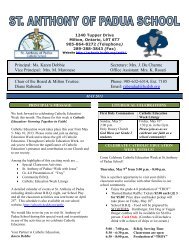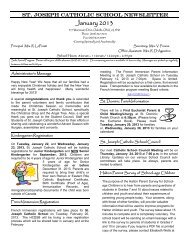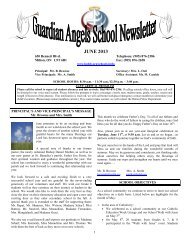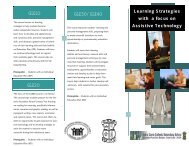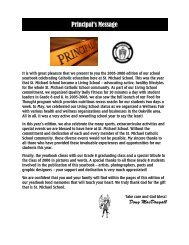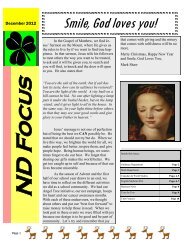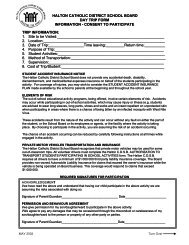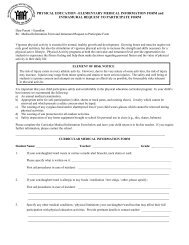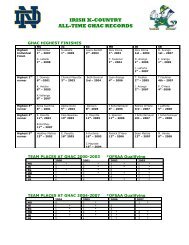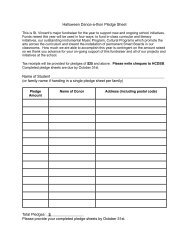Daily Physical Activity in Schools
Daily Physical Activity in Schools
Daily Physical Activity in Schools
You also want an ePaper? Increase the reach of your titles
YUMPU automatically turns print PDFs into web optimized ePapers that Google loves.
<strong>Daily</strong> <strong>Physical</strong> <strong>Activity</strong> <strong>in</strong> <strong>Schools</strong> | Sample Activities for Students<br />
Four Corner<br />
Fun<br />
Time<br />
20 m<strong>in</strong>utes<br />
Equipment Class set of a variety of balls;<br />
4 benches; floor tape (optional)<br />
Facility<br />
❏ Classroom ❏ Multipurpose<br />
✓❏ Gymnasium ❏ Outdoors<br />
<strong>Physical</strong> <strong>Activity</strong> Level<br />
✓❏ Moderate ✓ ❏ Vigorous<br />
Safety<br />
Rem<strong>in</strong>d students to be aware of personal space when mov<strong>in</strong>g around the activity area and to watch for other students mov<strong>in</strong>g <strong>in</strong> a variety of directions.<br />
Place benches on their sides with the seat area fac<strong>in</strong>g <strong>in</strong>wards, and a safe distance from corners and walls.<br />
Rem<strong>in</strong>d students of basic soccer safety tips (e.g., kick with the <strong>in</strong>side of the foot to keep the ball on the ground).<br />
Warm-up: Thunder, Lightn<strong>in</strong>g, and Snow (Adapted from: Ophea, H&PE Curriculum Support Document, Grade 3, 2000)<br />
Have students stand and move <strong>in</strong> response to the follow<strong>in</strong>g cue words:<br />
thunder: runn<strong>in</strong>g on the spot so you can hear your feet<br />
lightn<strong>in</strong>g: stand<strong>in</strong>g still<br />
ra<strong>in</strong>: stride jumps<br />
snow: walk<strong>in</strong>g with high knees<br />
Lead, or have a student lead, a stretch<strong>in</strong>g rout<strong>in</strong>e (see the Appendix for sample stretches).<br />
<strong>Activity</strong> 1: Build<strong>in</strong>g Blocks<br />
Have students move <strong>in</strong> various ways around the gymnasium (e.g., skipp<strong>in</strong>g, gallop<strong>in</strong>g, zigzagg<strong>in</strong>g, hopp<strong>in</strong>g).<br />
Call out “5-blocks”. Have students form groups with the number of students that was called out (i.e., five). (Note: If it is not possible for all<br />
groups to consist of an equal number of students, have most of the student form groups accord<strong>in</strong>g to the number called and the rema<strong>in</strong><strong>in</strong>g<br />
students form a group of their own.)<br />
Have students cont<strong>in</strong>ue mov<strong>in</strong>g aga<strong>in</strong> until another number is called out.<br />
F<strong>in</strong>ish with a number that will result <strong>in</strong> the formation of four groups.These groups can be used for the next activity.<br />
<strong>Activity</strong> 2: Four Corner Fun (Adapted from: CIRA Ontario, 50 Games with 50 Tennis Balls, 2004)<br />
Expla<strong>in</strong> that the ma<strong>in</strong> objective of this game is for each team to allow as few goals as possible.<br />
Assign each team a bench that they are responsible for defend<strong>in</strong>g. Rem<strong>in</strong>d students that there are no goalies <strong>in</strong> the game.<br />
Place all the balls <strong>in</strong>to the centre of the activity area. Have the students scatter and try to kick the balls to hit the bench of another team.<br />
When a ball hits a bench, it is a goal.Whenever students score a goal, they take that ball and place it beh<strong>in</strong>d the bench they scored on.<br />
Have students play until a designated time is reached or until all of the balls are gone.<br />
Cool-down: W<strong>in</strong>dstorm<br />
Have students walk around slowly, pretend<strong>in</strong>g they are trees blow<strong>in</strong>g <strong>in</strong> the w<strong>in</strong>d and us<strong>in</strong>g their arms as branches. Students start <strong>in</strong> a big<br />
w<strong>in</strong>dstorm <strong>in</strong> which branches break, and f<strong>in</strong>ish as the w<strong>in</strong>d stops blow<strong>in</strong>g.<br />
Lead, or have a student lead, a stretch<strong>in</strong>g rout<strong>in</strong>e (see the Appendix for sample stretches).<br />
Variations<br />
Increase the difficulty of the Build<strong>in</strong>g Blocks activity by call<strong>in</strong>g out math equations.<br />
Increase or decrease the number of balls or the size of balls used.<br />
Tell students they cannot score on the same goal twice <strong>in</strong> a row.<br />
Notes for Teachers<br />
Discuss with students how they would rate their level of participation<br />
and why they gave themselves that rat<strong>in</strong>g. How could they improve?<br />
Plann<strong>in</strong>g Notes and Reflection<br />
14



